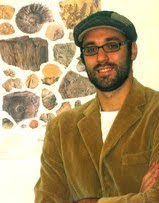A fractal-generated picture. Image from Wikipedia.
Some of the most emblematic figures of the Renaissance – da Vinci, Gesner, Aldrovandi, Bauhin – were pioneers of paleontology and demonstrated a visual interest in trace fossils. To decipher the reason for this aesthetic appreciation, I used fractal geometry to explore various ichnological drawings of the Renaissance (click here to read the full paper). Among analytical methods, fractal analysis proved to be the most efficient both in quantifying visual attractiveness and in describing the structure of complex patterns. In fact fractal geometry has been applied in studying visual perception itself and has been used to analyse abstract art, architecture and design.
Trace fossils in the Italian Renaissance: Cosmorhaphe, a "fractal trace" in Aldrovandi's Musaeum Metallicum.
I fed a software with images of trace fossils and their representations. What emerged amazed me. Several traces (i.e. graphoglyptids and chondritids) have fractional dimensionality and self-similarity over a significant range of measurement scales (fractal behaviour). Intriguingly, such "fractal traces" are among the most figured trace fossils of the Renaissance. Fractal traces are hierarchically structured and their whole geometric structure can be regarded as an expression of self-organization processes producing correlations between different orders of scale. Being rich in structure, such traces have been acknowledged by naturalists for their instant aesthetic appeal.
Bruce Pollock based this oil painting on fractal geometry.
Nevertheless, fractals are not only in trace fossils, but in many other natural objects and humans seem to display a consistent aesthetic preference across fractal images. For these reasons many artists have been inspired by fractals to produce their art; here are some examples related to Geology.
'Tile Pattern And Vauxia Sponge' by Michael A Coleman. Vauxia is a sponge from Burgess, a world-known fossil site.
Bruce Pollock's fractal art is inspired by nature, including geologic objects.
A very unusual introduction to fractals: Arthur Clarke (famous for his novel 2001: A Space Odyssey) presents "Fractals, the Colors of Infinity"








Thanks for the info, I find this topic really interesting and think you are on to something connecting geology, paleontology and art.
ReplyDeleteDid you know Jackson Pollock's art work is also thought to display properties of fractals?